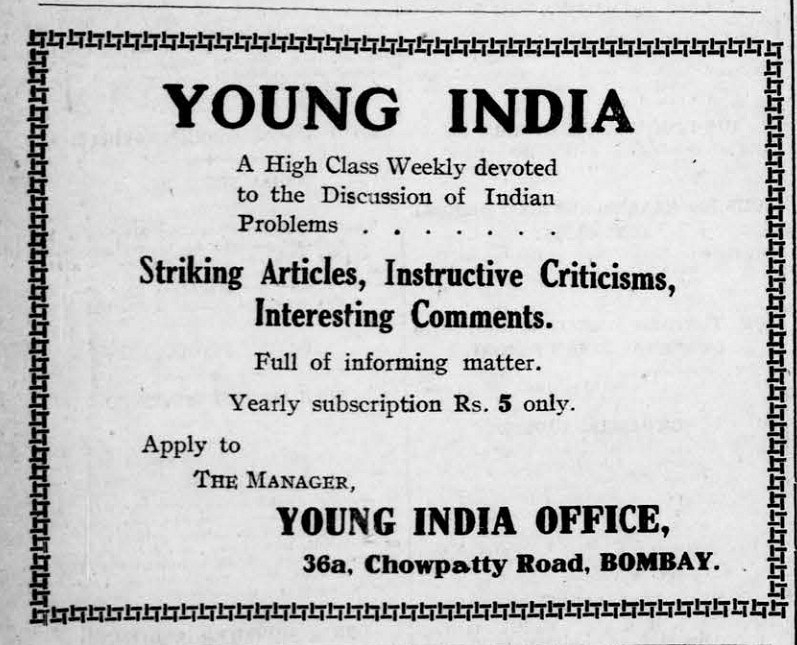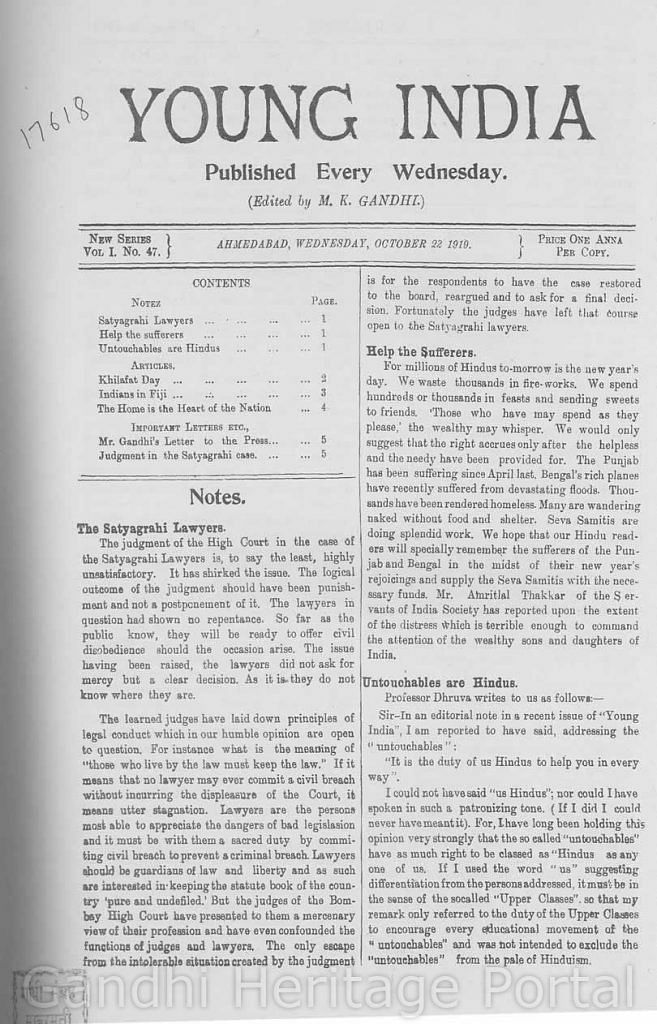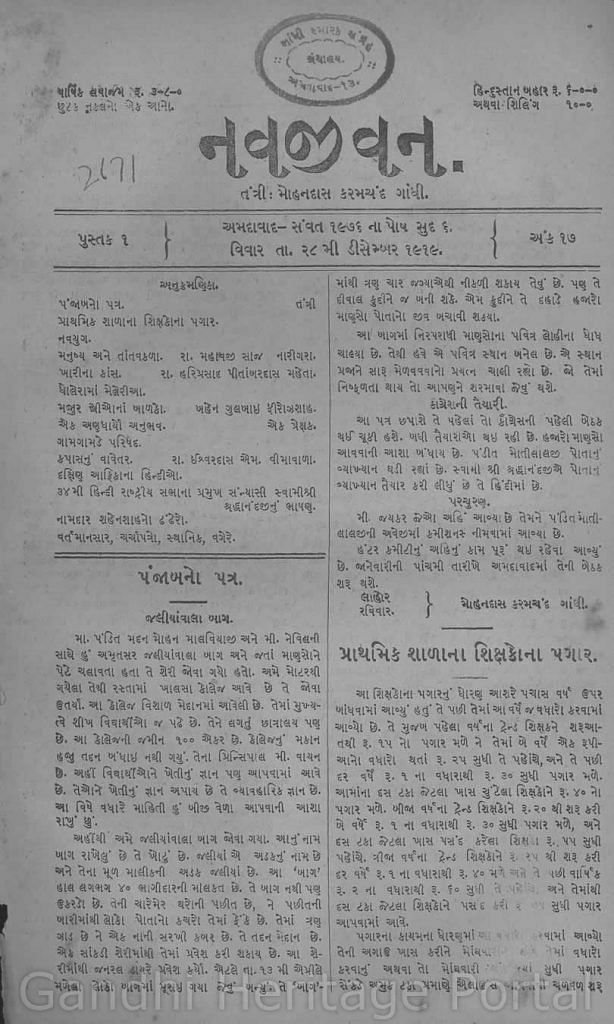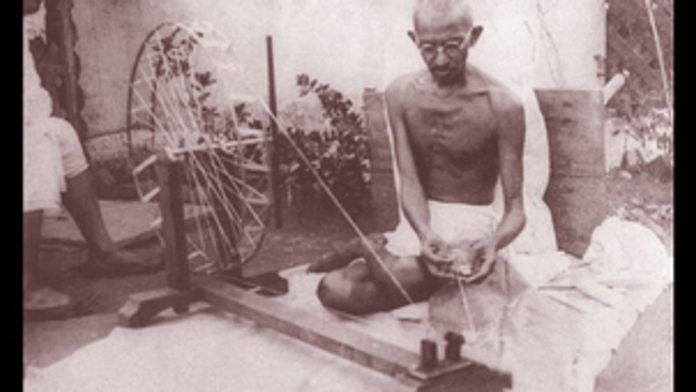Mohandas Karamchand Gandhi’s 150th birth anniversary coincides with another milestone: the centenary of his two magazines Young India and Navjivan (1919-1932). Both periodicals, under the editorship of Gandhi, covered issues like the first non-cooperation movement in 1921, the 1919-1924 Khilafat movement, Gandhi’s imprisonment under sedition charges in 1922 , highs and lows of Hindu-Muslim relations, debates on untouchability, Dandi March in 1930, the second Round Table Conference in 1931 and his visit to Europe in 1931.
With prior experience of owning a press and running a weekly paper the Indian Opinion in South Africa, Gandhi knew the nitty-gritty of journalism and the importance of owning a mouthpiece to convey his unique thoughts.
Gandhi the prolific editor
The first opportunity for Gandhi to run magazines in India arrived in 1919 when Umar Sobani and Shankarlal Banker, two young supporters of Home Rule League that fought for bringing self-rule in India, offered him the editorship of their weekly Young India. Incidentally, the Home Rule League of America was also bringing out a monthly with the same name, which had no connection with the Indian Young India.
This was playing out during the peak of the anti-Rowlatt Act movement in 1919. The British government in pre-independent India suppressed the daily The Bombay Chronicle, which had a nationalist perspective and deported its pro-movement British editor B. G. Horniman. Sobani and Banker, helming the agency’s managerial affairs, asked Gandhi to take over the responsibility of The Bombay Chronicle. But, when the paper had to shut down its operations due to government pressure, the duo suggested Gandhi take over their English weekly Young India to carry on the spirit of the freedom struggle. Gandhi too was “anxious to expound the inner meaning of Satyagraha to the public” and also desperate to help the cause of the “Punjab situation”, which worsened after the martial law excesses. (An Autobiography or The Story of My Experiments with Truth, M.K. Gandhi, Translated by Mahadev Desai, Navjivan Press, May 1940, Page 580)
In the meantime, Indulal Yajnik, a passionate young leader and associate of Sobani and Banker offered editorship of his Gujarati monthly Navjivan ane Satya to Gandhi. He accepted it readily and dropped Satya (truth) from the name, most probably because it was indicative of a merger of two different magazines Navjivan and Satya.

The first issue of Navjivan with Gandhi as the editor came out on 7 September 1919. Explaining “Our Aim”, Gandhi noted that “If anyone asks why, if I wished to serve India, I should not pour out my soul through English, I would say in reply that, being a Gujarati by birth and way of life, I can serve India best only by identifying myself completely with the life of Gujarat”.
Expressing his preference for conversing and writing in India’s regional languages, he wrote in the same article, “Navjivan will take every possible occasion to show that it is in vain that we are so infatuated with English”, but clarified, “I do not mean to say that English has no place at all in our studies or our life. I only insist that our present use of English is indiscriminate”. (7 September 1919, Navjivan, Page 3. English translation: Collected Works of Mahatma Gandhi, Volume-16, Page 94)
Young India under Gandhi was a bi-weekly publication, but the additional responsibility of supervising the weekly Navjivan forced Gandhi to turn Young India into a weekly newspaper. Gandhi ran both the magazines from Ahmedabad, at times publishing an extra midweek edition or additional pages to its routine 8-page issue. The period from 1919 to 1921 saw a steep rise in the circulation of his two weeklies along with a surge in the Indian freedom movement.

Gandhi once noted, “Both of them reached a very wide circulation which at one time rose to the neighbourhood of forty thousand each”. He also observed a pattern, “While the circulation of Navjivan went up faster, Young India increased only by slow degrees”.
Also read: Ambedkar was wrong, Gandhi wrote against untouchability in Gujarati journals too
Reaching masses
Gandhi’s prison term after the famous sedition case in 1922, for writing two particular articles in Young India, resulted in a drop in the circulation of the two periodicals — reaching below 8,000 copies. (An Autobiography or The Story of My Experiments with Truth, M.K. Gandhi, Translated by Mahadev Desai, Navjivan Press, May 1940, Page 581) Despite this setback, Gandhi termed Navjivan as ‘weekly report of the progress of Swaraj’.
His widely known autobiography An Autobiography: The Story of My Experiments with Truth was first serialised in Navjivan as a history of the satyagraha movement in South Africa. Both the magazines, printed on full-scape size paper, had eight pages of content without any advertisement, presented in a double-column layout. The year-ender issue would give a complete subject and article index of the numerous issues covered throughout the year. Gandhi would be very punctual about meeting deadlines and would send his contributions by post even when he was travelling.
These magazines became live platforms for Gandhi to interact with the masses. He would agree to print nasty letters, but replied to them with patience, coherently putting across his viewpoint. He was ably aided by his multi-talented secretary Mahadev Desai who was proficient in both Gujarati and English. Gandhi’s other associates like activists and writers Swami Anand, Kaka Kalelkar, Narhari Parikh contributed to Navjivan and shaped Gujarati language and translations of that era. They also ran the paper when Gandhi was imprisoned in the sedition case. One can read a few articles and appeals of Vallabhbhai Patel in Navjivan, especially during Gandhi’s imprisonment.

Also read: Gandhi wasn’t the only freedom leader to miss Nehru’s 1947 I-Day speech. There were others too
The death of the two magazines
Both Young India and Navjivan had to be closed down due to Gandhi’s arrest and the crackdown on the satyagraha movement in 1931. Young India continued to come out in cyclostyled version of 3 pages and even regained its regular form before finally closing down in 1932. Navjivan had its last regular issue on 10 January 1932 followed by a couple of two-page issues before its final closure.
Lawyer and novelist K. M. Munshi, a member of Yajnik-Sobani-Banker group and later a member of the Constituent Assembly, paid a befitting tribute to Navjivan in his 1948 book Gandhi: The Master. “Few other newspapers in the world have had a similar popularity and influence in their area of circulation as this small, unostentatious sheet which never screamed a headline and never published an advertisement. With many, it replaced the novel and the Purana in interest. A single copy of this weekly has often brought to a distant hamlet its only journal and gospel of life”. (Gandhi: The Master, Rajkamal Publications Ltd., Delhi, 1948, Page 49)
The author is a senior columnist and writer based in Ahmedabad. Views are personal.
This is the second edition of the four-part series on Mahatma Gandhi ahead of his 150th birth anniversary. Read the first article here, third and fourth editions.




Gandhian Thought.
Truth, nonviolence, Sarvodaya and Satyagraha and their significance constitute Gandhian philosophy and are the four pillars of Gandhian thought.
What is Gandhian ideology? :
Gandhian ideology is the set of religious and social ideas adopted and developed by Mahatma Gandhi, first during his period in South Africa from 1893 to 1914, and later in India.
Gandhian philosophy is not only simultaneously political, moral and religious, it is also traditional and modern, simple and complex. It embodies numerous Western influences to which Gandhiji was exposed, but is rooted in ancient Indian culture harnessing universal moral & religious principles.
The philosophy exists on several planes – the spiritual or religious, moral, political, economic, social, individual and collective.
The spiritual or religious element, and God, are at its core.
Human nature is regarded as fundamentally virtuous.
All individuals are believed to be capable of high moral development, and of reform.
Gandhian ideology emphasises not on idealism, but on practical idealism.
Gandhian philosophy is a double-edged weapon.Its objective is to transform the individual and society simultaneously, in accordance with the principles of truth and non-violence.
Gandhiji developed these ideologies from various inspirational sources vis Bhagvad Geeta,Jainism, Buddhism, Bible, Gopal Krishna Gokhale, Tolstoy, John Ruskin among others.
Tolstoy’s book ‘The Kingdom of God is within you’ had a deep influence on Mahatma Gandhi.
Gandhiji paraphrased Ruskin’s book ‘Unto this Last’ as ‘Sarvodaya’.
These ideas have been further developed by later “Gandhians”, most notably, in India by, Vinoba Bhave and Jayaprakash Narayan and outside of India by Martin Luther King Jr. and others.
Major Gandhian Ideologies
Truth and nonviolence: They are the twin cardinal principles of Gandhian thoughts.
For Gandhi ji, truth is the relative truth of truthfulness in word and deed, and the absolute truth – the ultimate reality. This ultimate truth is God (as God is also Truth)and morality – the moral laws and code – it’s basis.
Nonviolence, far from meaning mere peacefulness or the absence of overt violence, is understood by Mahatma Gandhi to denote active love – the pole opposite of violence, in every sense. Nonviolence or love is regarded as the highest law of humankind.
Satyagraha: Gandhiji called his overall method of nonviolent action Satyagraha. It means the exercise of the purest soul-force against all injustice, oppression and exploitation.
It is a method of securing rights by personal suffering and not inflicting injury on others.
The origin of Satyagraha can be found in the Upanishads, and in the teachings of Buddha, Mahavira and a number of other other greats including Tolstoy and Ruskin.
Sarvodaya- Sarvodaya is a term meaning’Universal Uplift’ or ‘Progress of All’. The term was first coined by Gandhi ji as the title of his translation of John Ruskin’s tract on political economy, “Unto This Last”.
Swaraj- Although the word swaraj means self-rule, Gandhiji gave it the content of an integral revolution that encompasses all spheres of life.
For Gandhiji, swaraj of people meant the sum total of the swaraj (self-rule) of individuals and so he clarified that for him swaraj meant freedom for the meanest of his countrymen. And in its fullest sense, swaraj is much more than freedom from all restraints, it is self-rule, self-restraint and could be equated with moksha or salvation.
Trusteeship- Trusteeship is a socio-economic philosophy that was propounded by Gandhiji.
It provides a means by which the wealthy people would be the trustees of trusts that looked after the welfare of the people in general.
This principle reflects Gandhiji’s spiritual development, which he owed partly to his deep involvement with and the study of theosophical literature and the Bhagavad Gita.
Swadeshi : The word swadeshi derives from Sanskrit and is a conjunction of two Sanskrit words. ‘Swa’ means self or own and ‘desh’ means country. So swadesh means one’s own country. Swadeshi, the adjectival form, means of one’s own country, but can be loosely translated in most contexts as self-sufficiency.
Swadeshi is the focus on acting within and from one’s own community, both politically and economically.
It is the interdependence of community and self-sufficiency.
Gandhiji believed this would lead to independence (swaraj), as British control of India was rooted in control of her indigenous industries. Swadeshi was the key to the independence of India, and was represented by the charkha or the spinning wheel, the “center of the solar system” of Mahatma Gandhi’s constructive program.
Relevance in Today’s Context :
The ideals of truth and nonviolence, which underpin the whole philosophy, are relevant to all humankind, and are considered as universal by the Gandhians.
More than ever before, Mahatma Gandhi’s teachings are valid today, when people are trying to find solutions to the rampant greed, widespread violence, and runaway consumptive style of living.
The Gandhian technique of mobilising people has been successfully employed by many oppressed societies around the world under the leadership of people like Martin Luther King in the United States, Nelson Mandela in South Africa, and Aung San Suu Kyi in Myanmar, which is an eloquent testimony to the continuing relevance of Mahatma Gandhi.
Dalai Lama said, “We have a big war going on today between world peace and world war, pandemic virus fight in the World with every body and it is totally between the force of mind and force of materialism, between democracy and totalitarianism.” It is precisely to fight these big wars that the Gandhian philosophy needed in contemporary times.
Mr. Barack Obama is right when he said :
” In my life, I have always looked to Mahatma Gandhi as an inspiration, because he embodies the kind of transformational change that can be made when ordinary people come together to do extraordinary things.” -Barack Obama.
Gandhian Ideologies in sum Gandhian ideologies shaped the creation of institutions and practices where the voice and perspective of everyone can be articulated, tested and transformed ; According to him, democracy provided the weak with the same chance as the strong; Functioning on the basis of voluntary cooperation and dignified & peaceful co-existence was replicated in several other modern democracies. Also, his emphasis on political tolerance and religious pluralism holds relevance in contemporary Indian politics.; Truth, nonviolence, Sarvodaya and Satyagraha and their significance constitute Gandhian philosophy and are the four pillars of Gandhian thought.
What can we learn from Mahatma Gandhi’s life?. Of all the things, truthfulness was the most important for Gandhi. He not only preached the truth, but also practiced it. When Gandhi was young, he once lied to his father and regretted the decision. By following this simple thought from Gandhi, you can see a huge difference in the way people perceive and treat you.
B.G.Ramaprasad
Bengaluru
Dated : 1-10-2020.
Show quoted text
When will India be rid of this old man? His peculiar mix of politics with religion and odd moralistic stands delayed India’s freedome by at least a decade and a half. His views are regressive and unsuited for this technology driven era. No one’s ideology can be a panacea forever. Gandhian thoughts should not become another religion.